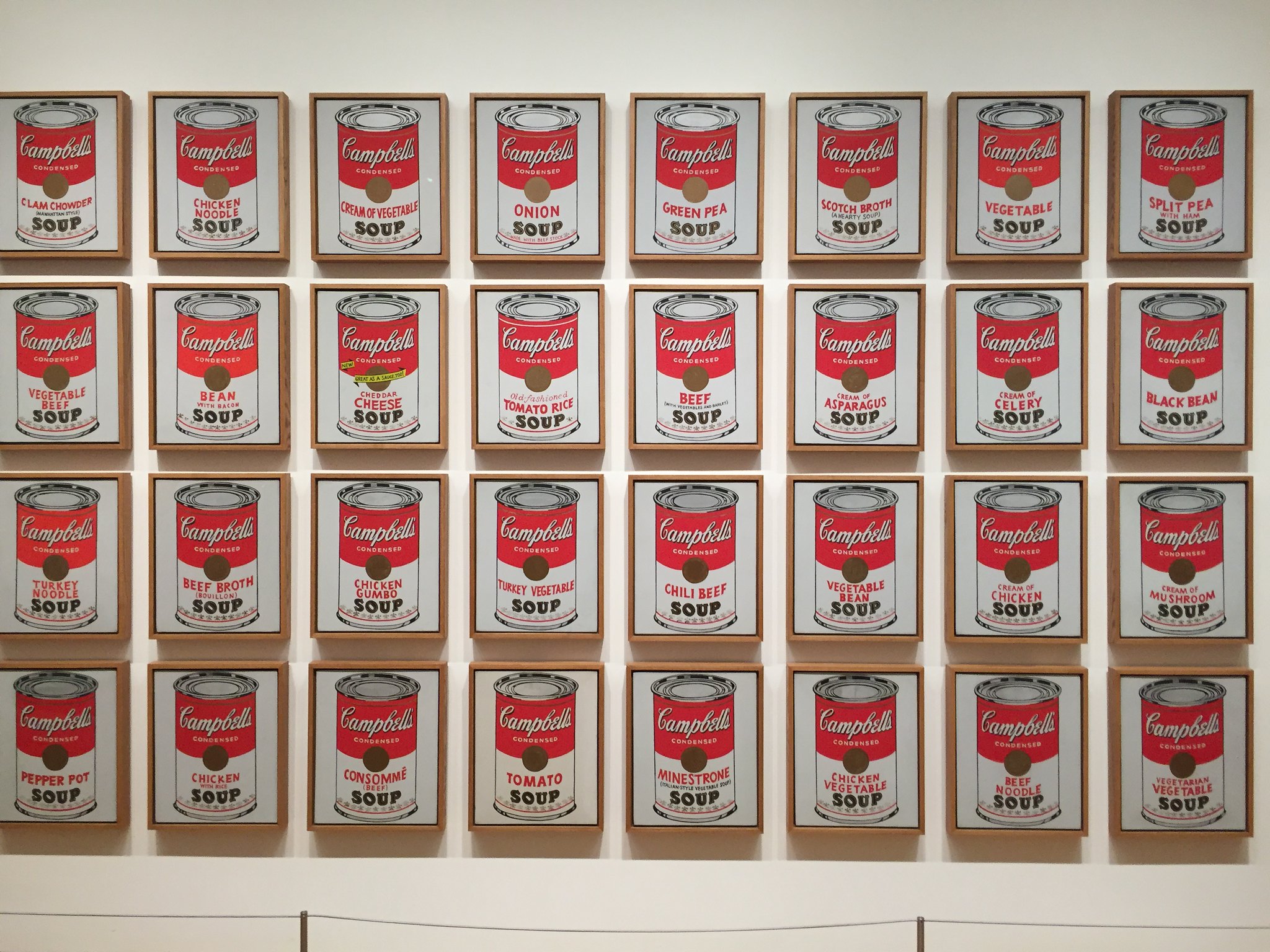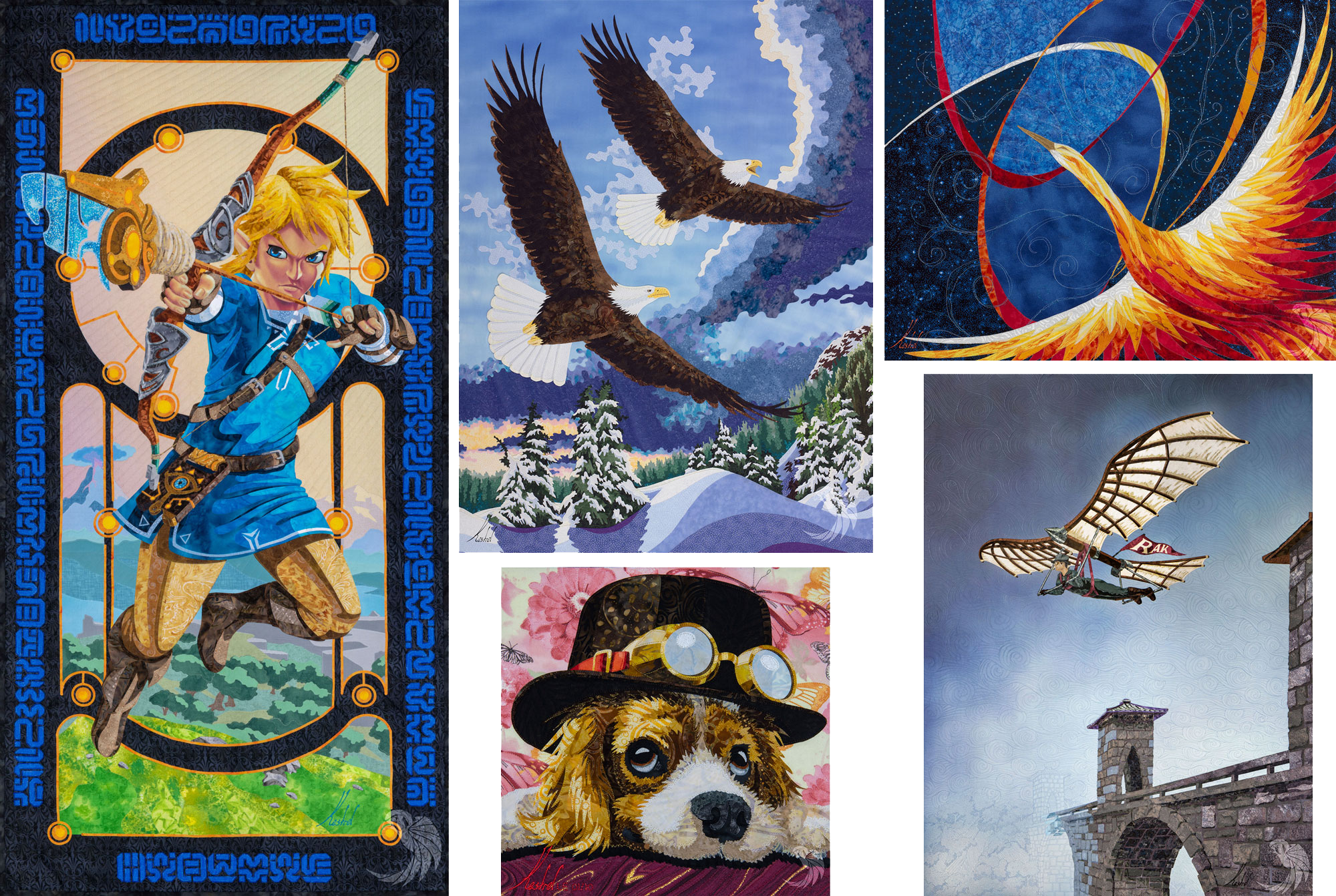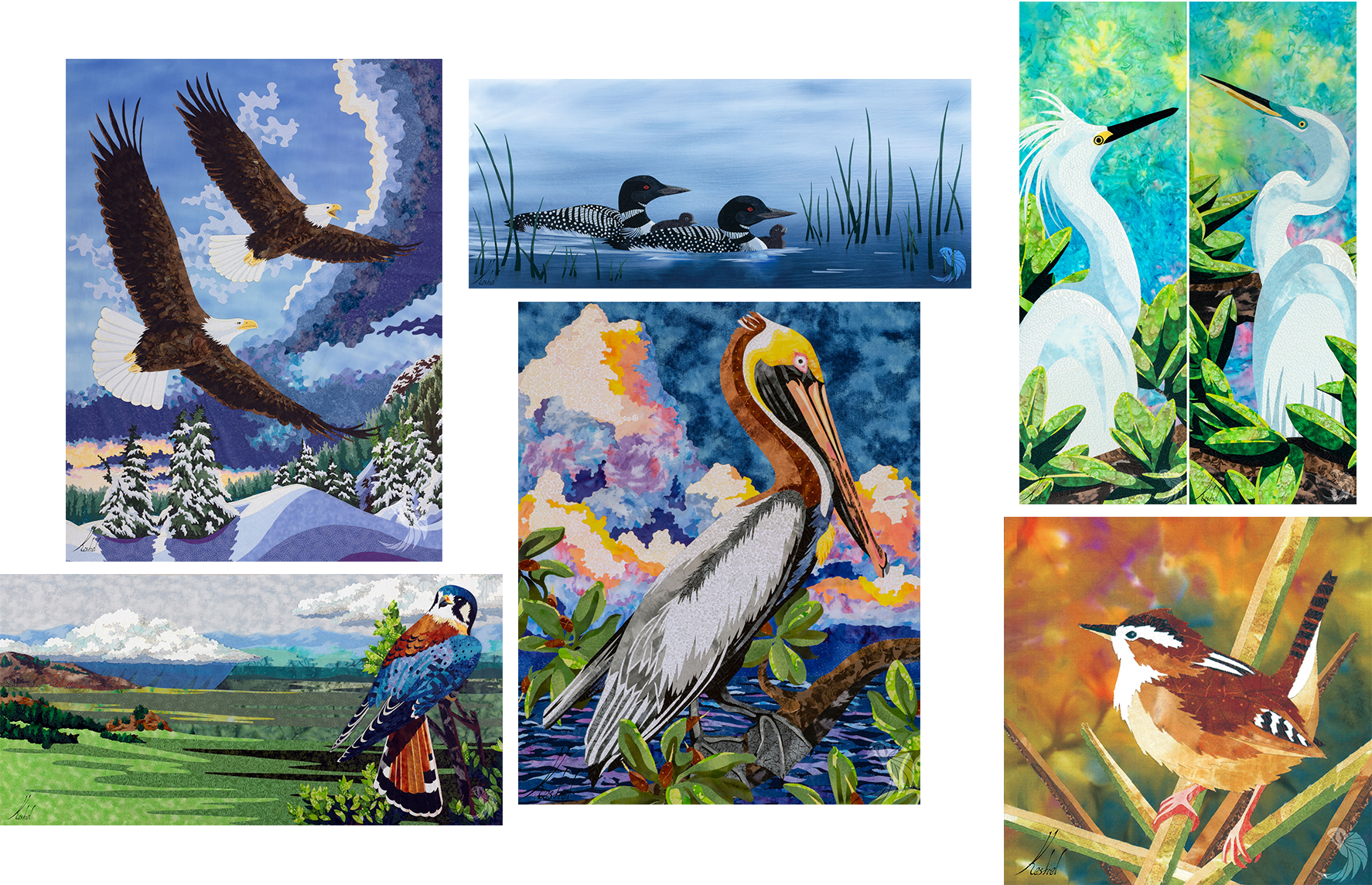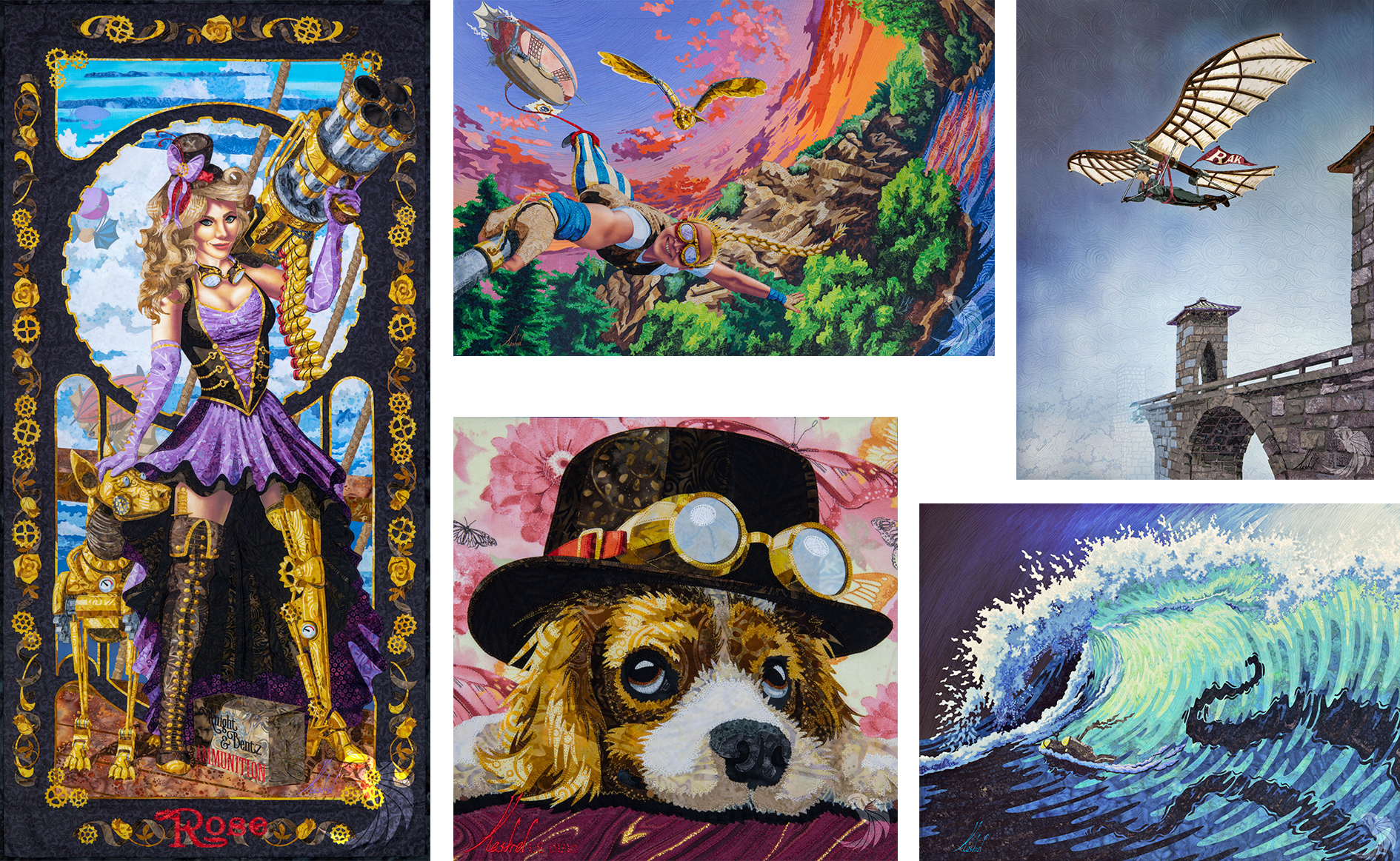How to Work in a Series
- Published:
- Length: 1813 words
- Reading Time: 10 minutes
The other day, I was in a Zoom call with a group of fellow quilt artists, and the topic of working in a series came up in conversation — specifically, how does one go about making a series? I admit I didn't contribute much to the discussion, mostly because I didn't know how to answer.
"How do I work in a series?" is not a question I've ever had to answer for myself. Making fabric artwork is literally all I've ever wanted to do as an artist, so working in a series came naturally. But saying, "I just do the same thing all the time" isn't a quantifiable reason for why my work looks like it belongs in a series. Not having an answer bothered me, so it stuck in my brain and — as usual with anything that makes me reverse engineer my own art — eventually turned into this blog post.
I've split this topic into subsections in the following order, so feel free to jump ahead if you wish:
- What is a series?
- What makes for a visual connection within a series?
- The Series Formula
What is a series?

A series is a collection of work that visually looks like it belongs together. Each individual artwork within the series stands on its own as a unique creation while still relating to the rest of the group. It's a balance between individualism and conformity.
Clara Lieu, an artist and Adjunct Professor at the Rhode Island School of Design (RISD), published her thoughts on her blog:
In my opinion, a strong series of artworks is like a really good television show. You want to have details that make the show distinctive, but the fundamental premise has to be open enough that many contrasting episodes can be generated. If you think about the television show “Cheers,” the premise was remarkably simple: people working and hanging out in a bar.
Even though the vast majority of the show was filmed in one location, the writers were able to play out many seasons of distinctive episodes. There was a balance between the simplicity of the situation, yet there was tons of flexibility for diverse story lines.
— "Ask the Art Prof: How Does a Visual Artist Create a Series of Artworks?" by Clara Lieu, published July 2, 2013. URL
What about quantity?
How many artworks within a collection are required for that collection to be considered "a series"? There's no set rule or regulation, but the general consensus among fine art professionals is "at least five". Any collection of works numbering fewer than five may share a theme but are not yet a series. Part of the purpose of a series is for an artist to demonstrate he/she can stick to an idea, so a sufficient number of individual works are required to show the artist can persevere in exploring that theme to its full potential.
On the other end of the spectrum, there is no maximum number of artworks that can be within a series. In the example of Andy Warhol's Campbell's Soup Cans up above, that series is made from 32 paintings. If an artist wishes to explore the same theme in her work for her entire life, all of the work he/she produces could be within the same series.
What makes for a visual connection within a series?
More than just sharing a theme, artworks within a series must share a visual connection so they look like they go together. When thinking about my own work, my first thought had been that all of my work looks like it belongs to the same series. After all, I've been using the same method of creating fabric art and quilts for 17 years, and all of my work has the same visual style; of course it all looks like it belongs together. But after some further contemplation, I realized that isn't actually correct.
I have used the same method of creating fabric art for almost two decades; that part is true. But although the majority of my work does conform to the same style, some of it is different. I've experimented with different looks now and then over the years, and those works stand out as "different".
The five artworks above are all made from the same method of fused appliqué fabric. They share enough characteristics that they look like they might have been created by the same artist (which they were), but they certainly don't look like they belong in the same series. That means more than one common factor must be shared by all the artwork in a series in order for that work to look like a series.
Here's another example:
{{ figure(src="/images/2021/kc-grapes-artwork.png", alt="Artwork by KC Grapes", caption="Artwork by KC Grapes.) }}
The above work was all created by my mother, KC Grapes, who is a very talented artist. The theme she has explored for her entire life has always been "animals" — both wild and domestic. However, Mom has never stuck to one visual style or medium — the works above were made from acrylic, oil, batik, fabric, pastel, and colored pencil. The only similarity in Mom's work is the subject of animals, but that one commonality isn't enough for these works to belong in the same series.
Adding a second criteria
The common denominator for all of my work is the method in which it was created — my personal process of fused appliqué. What if I add a second requirement? Take a look:
The above artwork is all fused appliqué, but each image features at least one wild bird. That was my second rule. I feel this collection of seven images is a successful series, despite having a number of other inconsistencies between these images. They use different color palettes and vary widely in size (Bald Eagles is 30" x 40" while Marsh Wren is only 8" x 8"). Only two of the above artworks use hand-dyed fabrics, and one of the seven uses tulle. Only one image shows birds flying; all the others are at rest. But these birds still look good together, so it seems having a second rule was enough.
"Wild birds" is a rather specific subject, so what if I open that up to something broader? I went back through my portfolio and selected a new collection of images:
This time I broadened my criteria to "animals". The above art features mammals, birds, insects, and a reptile. Some of them are domesticated, some are wild. The sizes once again vary widely (Beauty Queen, the alligator picture, is 48" x 36". Country Morning Rooster is 8" x 10"), as do the color palettes. One of these images uses hand-dyed fabrics. Two of them are quilts, but the other three have no stitching at all. This series isn't quite as cohesive as the wild birds, but I still think it works.
Just for fun, I decided to try one more. In recent years I've been making artwork that shows scenes from my imaginary steampunk world, but I've not thought of these works collectively as a series. Do they work together?
To be perfectly honest, I don't think these five work together as a series. Rose (far left) certainly doesn't belong — her decorative border and art nouveau background are too out of place. Three of these artworks — Leap of Faith (top center), Morning Commute (top right), and There's Something in the Water (bottom right) — are a good start, but three is not enough for a series. I'm glad I did this exercise because now I know what to be mindful of in the future if I plan to make a Steampunk series.
The Series Formula
What do my deductions mean for you if you're trying to make your own series of art? I like understanding why certain things are the way they are — and coming up with formulas when possible — because understanding means repeatability. It would be impossible for me to repeat a success if I don't understand why that thing was successful in the first place. If I have a formula to follow the second time around, even better. Based on the exercises I went through up above, here is my advice to any of you looking to make a series of your own.
Set a minimum of two rules for your series. These rules can be anything you want, but should be somewhat specific. Here are some examples from the top of my head:
- All art in this series will be wholecloth
- All art in this series will depict scenes from nature
- All art in this series will use a warm color palette
- All art in this series will explore the idea of "transformation"
- All art in this series will be portraits
- All art in this series will be 1:1 ratio (square) in size
- All art in this series will be made from my own hand-dyed fabrics
You can add additional rules if you like (and indeed, if your first two rules are too broad, you might need additional guidelines to help your work look cohesive.)
Pick rules that you're interested in exploring within because you need at least five individual artworks to work as a series.
Don't worry about having ideas for your entire series before you begin. If you have an idea for one or two artworks, that's plenty to get started. You will undoubtedly think of more as you're working through your first artworks.
I like to think of my art style as my box. My specific method of using fused appliqué fabric pieces to make artwork is the limit I've set for myself; that's my boundary, or my box. But just like a child who can get hours of enjoyment from any cardboard container, within my box the possibilities are limitless. Make your own box, and then let your imagination go wild!
